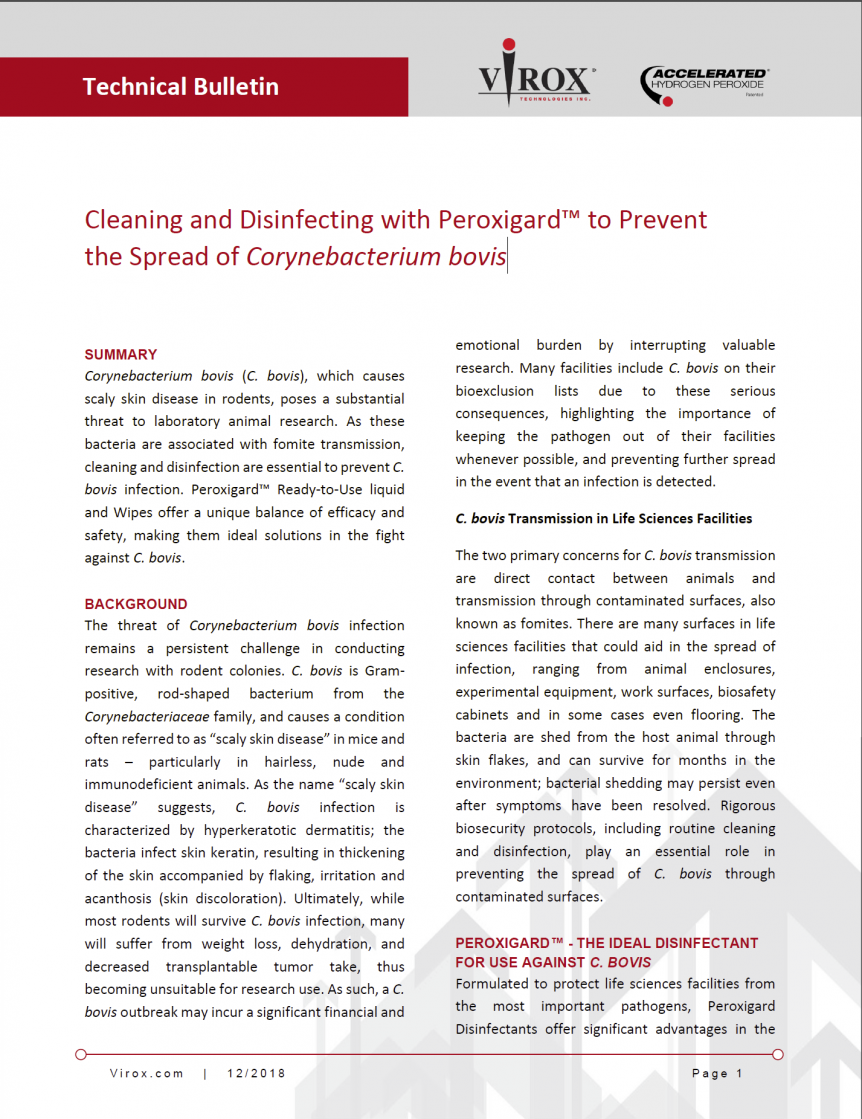Corynebacterium bovis (C. bovis), which causes scaly skin disease in rodents, poses a substantial threat to laboratory animal research. As these bacteria are associated with fomite transmission, cleaning and disinfection are essential to prevent C. bovis infection. Peroxigard™ Ready-to-Use liquid and Wipes offer a unique balance of efficacy and safety, making them ideal solutions in the fight against C. bovis.
BACKGROUND
The threat of Corynebacterium bovis infection remains a persistent challenge in conducting research with rodent colonies. C. bovis is Gram-positive, rod-shaped bacterium from the Corynebacteriaceae family, and causes a condition often referred to as “scaly skin disease” in mice and rats – particularly in hairless, nude and immunodeficient animals. As the name “scaly skin disease” suggests, C. bovis infection is characterized by hyperkeratotic dermatitis; the bacteria infect skin keratin, resulting in thickening of the skin accompanied by flaking, irritation and acanthosis (skin discoloration). Ultimately, while most rodents will survive C. bovis infection, many will suffer from weight loss, dehydration, and decreased transplantable tumor take, thus becoming unsuitable for research use. As such, a C. bovis outbreak may incur a significant financial and emotional burden by interrupting valuable research. Many facilities include C. bovis on their bioexclusion lists due to these serious consequences, highlighting the importance of keeping the pathogen out of their facilities whenever possible, and preventing further spread in the event that an infection is detected.
C. bovis Transmission in Life Sciences Facilities
The two primary concerns for C. bovis transmission are direct contact between animals and transmission through contaminated surfaces, also known as fomites. There are many surfaces in life sciences facilities that could aid in the spread of infection, ranging from animal enclosures, experimental equipment, work surfaces, biosafety cabinets and in some cases even flooring. The bacteria are shed from the host animal through skin flakes, and can survive for months in the environment; bacterial shedding may persist even after symptoms have been resolved. Rigorous biosecurity protocols, including routine cleaning and disinfection, play an essential role in preventing the spread of C. bovis through contaminated surfaces.
PEROXIGARD™ – THE IDEAL DISINFECTANT FOR USE AGAINST C. BOVIS
Formulated to protect life sciences facilities from the most important pathogens, Peroxigard Disinfectants offer significant advantages in the battle against C. bovis across several key criteria:
• Efficacy: Unlike many commonly-used products, Peroxigard Ready-to-Use (RTU) liquid and Wipes carry EPA-approved efficacy claims against C. bovis. This indicates that efficacy against C. bovis has been validated by stringent, independent testing at an EPA-recognized laboratory, and that supporting data has been federally approved.
• Rapid Contact Time: Among products with an approved C. bovis claim, many require unrealistically long contact times, in some cases 10 minutes, to be effective. Peroxigard RTU and Wipes are effective against C. bovis in 2 minutes, streamlining protocols and making compliance easy, by eliminating the risk of premature evaporation of the disinfectant before the contact time is achieved.
• Ease of Use: Peroxigard is available in convenient pre-moistened wipes formats and RTU liquid; for use against C. bovis. Unlike other commonly-used products, no dilution or activation is required, and products carry a 3-year shelf life, reducing waste and saving time. This is in stark contrast to the short shelf lives associated with other products, in some cases only seven days, leading to excess waste and labor costs.
• Safety: Despite being highly effective against pathogens, Peroxigard RTU and Wipes are non-irritating to eyes and non-corrosive to skin, andare not associated with any other health hazards. This ensures that safety to the user or animal will not be compromised in the effort to fight infection.
CONCLUSION
C. bovis poses a significant threat to many research animals, and disinfection of fomites throughout life sciences facilities is a critical cornerstone in the fight against infection. By implementing Peroxigard (US) RTU and Wipes, facilities can feel confident that their disinfectant is offering exceptional efficacy against this pathogen, without causing collateral damage to animals or users.
To view the full Technical Bulletin [PDF], see below:
Technical Bulletin - C. bovis


